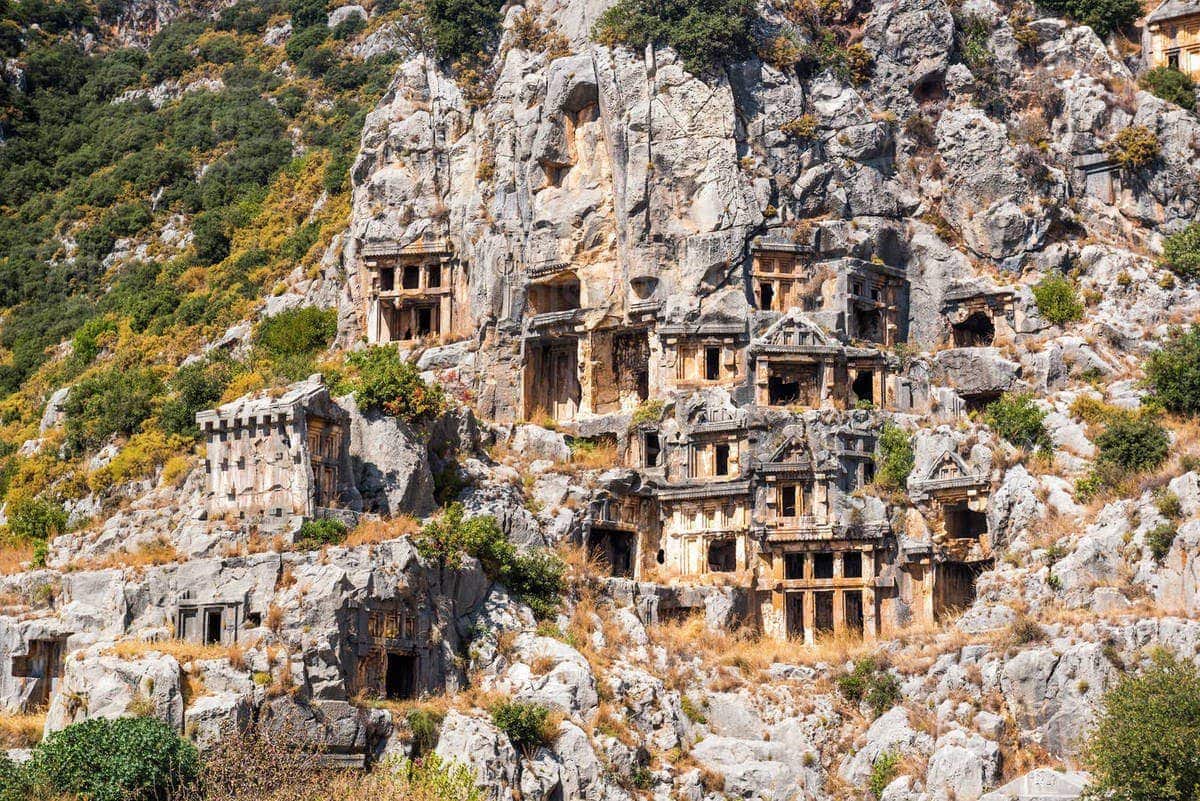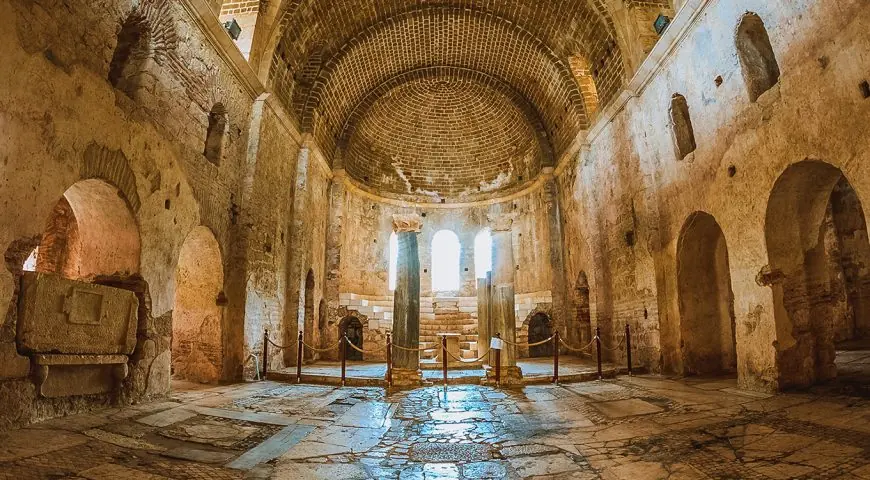One of the most powerful cities of the Lycian Union, the ancient city of Myra is known for its perfectly preserved Roman era amphitheatre and its tombs carved in the rocks overlooking the amphitheatre. This site is renowned mostly for being the home of the Saint Nicholas, known also as Santa Claus. Myra Ancient City is among the most beautiful examples of its kind in Anatolia. The rock tombs, which should be visited, and the ruins of the Myra ancient theatre reflect the characteristics of Roman engineering. This theatre is as impressive as those of Perge, Aspendos and Selge.

Thanks to its fertile and cultivated plain, Myra has been a centre of attraction throughout history.
History of Myra
Myra, which was among the six important cities of the Lycian Union with three voting rights, was named after the Myros River (Demre Stream) where it was founded. The story of Myra, which was the capital of Lycia civilization for a period, begins with the grave reliefs, and ends in the sea with the Port of Andriake. This is also known as the place where Goddess Kybele was Artemis.
Archaeological Ruins: Places to be visited include especially the magnificent tombs carved in the rocks, the theatre which has a capacity of around 6500, the temple, the agora, the antique port structures and the Church of Saint Nicholas. Ancient Myra is renowned for having the largest amphitheatre in Lycia and an outstanding collection of rock-cut tombs that have been carved into the cliffs. The ruins of Myra lie just to the north of Demre, which is a popular stop on Gulet cruise cabin charters along the Mediterranean Coast of Turkey.
There are still some remains to be unearthed in Myra, which lived its most glorious time in the 2nd and 3rd centuries AD.
Saint Nicholas Church
Myra is the city where Saint Nicholas was a bishop in 4th century AD. He is an important religious figure for Eastern Orthodox Christians and Roman Catholics all around the world.
The birthplace of Saint Nicholas was actually in Patara and he lived much of his life in Myra at modern-day Demre. So how did this 4th-century Christian saint and Greek bishop become the bearded, red-suited Santa Claus we know today?
Nicholas was born into a wealthy Greek Christian family in Greek Anatolia in the Mediterranean port of Patara. He was devoted to religion from an early age, observing the canonical fasts of Wednesdays and Fridays. After his parents died in an epidemic, Nicholas went to live with his uncle who was the bishop of Patara and who later ordained him as a priest.
Nicholas is believed to have made a pilgrimage to Egypt and the Holy Land sites of Golgotha and the Holy Sepulchre between 312 and 315 AD, living in a mountain cave with Anatolian monks overlooking Bethlehem. The Saint Nicholas Greek Orthodox Church is today located on the site of the cave in Beit Jala where he resided and a text written by Nicholas is kept by the Greek Orthodox Patriarch of Jerusalem.
After his years in the Holy Land, Nicholas then returned to Asia Minor and was consecrated as the bishop of Myra. His church still stands today and has become an important pilgrimage site for Christians from across the globe, with beautiful interior frescoes. A bronze statue of the saint was created by Russian sculptor Gregory Pototsky and positioned prominently outside the church.
Saint Nicholas Church which is on the UNESCO Tentative List to become a world heritage site.

Today’s church however, dates to the 7th century and the Saint’s supposed sarcophagus is not considered genuine, the original having been destroyed in 1087 by Italian merchants absconding with most of the bones it contained. The present museum, gardens and the quirky souvenirs available are a pleasant distraction. Tales abound of his kind deeds and indeed veritable miracles attributed to Saint Nicholas, the following of which will have a familiar tone;
The Tale of the Three Sisters: Near the Church of Saint Nicholas there lived a poor man who had three daughters. In order to be married , a dowry had to be offered and the man was unable to provide enough for even one of the girls. One cold winter night, the three sisters were discussing their predicament and the eldest suggested she sell herself as a slave in order to save the other two. The younger sisters protested and each offered herself instead. Upon hearing their argument Saint Nicholas secretly threw a bag of gold from the Church through the open window. It was December the 25th. By throwing a bag of gold through the same window one year later, the second daughter was able to marry. In the third year, the weather was particularly cold and as the window would be closed Saint Nicholas was obliged to climb onto the roof and throw the last bag of gold down the chimney. Whereupon, it fell into the youngest daughter’s stockings, hung up to dry over the stove.! Every year on the morning of 25th December, the poor families of Myra, discovered golden apples, snacks and toys, mysteriously arrived on their doorsteps. Saint Nicholas chose this way of helping the people so that he would not gain praise for himself but was discovered one year by the night-guard and acclaimed thereafter as Father Christmas.
Myra Örenyeri, 07570 Demre/Antalya, Turkey

